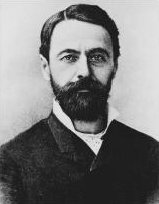Mobile process
Methanol to Gasoline ( MtG ) is a Mobil process to produce other low- octane petrol from methanol or dimethyl ether by catalytic conversion on a zeolite catalyst . By varying the catalyst and the process conditions, the selectivity to olefins ( Methanol to Olefins , MtO), to aromatic-rich products (Methanol to Aromatics, MtA) or to propylene (Methanol to Propylene, MtP) is shifted.
history
In 1880 J. Le Bel and WH Greene observed that the conversion of methanol over molten zinc chloride formed not only methane but also hexamethylbenzene .
The reaction was interpreted as the dehydrocyclization of ethene to benzene with subsequent Friedel-Crafts alkylation by methyl chloride .
In 1914 E. Sernagiotto investigated the conversion of methanol to phosphorus pentoxide , which led to the formation of an olefin mixture.
In 1928, Homer Martin Adkins and Philip D. Perkins described the dehydration of methanol using aluminum oxide catalysts to give dimethyl ether. The Russian chemists Matyushenskii and Freidlin discovered in their attempts to cleave dimethyl ether, which was an undesirable by-product in the production of methanol , on Al 2 O 3 / TiO 2 catalysts that ethene was formed under suitable reaction conditions.
In 1925, Franz Fischer and Hans Tropsch developed the Fischer-Tropsch synthesis for the production of liquid hydrocarbons from carbon monoxide and hydrogen. In 1956, Fawcett and Howk reported the conversion of methanol to hydrocarbon mixtures under Fischer-Tropsch conditions. The question arose whether methanol only serves as a source of carbon monoxide / hydrogen gases in such syntheses.
In the early 1970s, Mobil researchers developed the methanol-to-gasoline process using ZSM-5 zeolites.
Procedure
On zeolite catalysts (ZSM-5), an aromatic-rich hydrocarbon mixture is formed via the intermediate product dimethyl ether .
The hydrocarbon mixture goes up to C 10 aromatics (tetramethylbenzene durene ).
The process can be carried out in a fixed bed or fluid bed method. The fixed bed process is carried out in two stages. In the first step, the methanol is dehydrated to dimethyl ether. This step is carried out catalytically at pressures between 14 and 24 bar and temperatures around 400 ° C. In the second step, the dimethyl ether is converted to a carburetor fuel on ZSM-5 in the same temperature and pressure range. The catalyst cokes in the course of the process and has to be freed from the coke by burning off. In the fluidized bed process, the dehydration of the methanol takes place in the same step as the conversion of the dimethyl ether. The catalyst is continuously discharged and regenerated.
In Germany from 1982 to 1989 a pilot plant based on the fluidized bed process was operated by the companies Mobil Oil , UK Wesseling and Uhde in order to lay the technical foundations for future large-scale application. The plant had a capacity of 25 tons / day and was integrated into the refinery of Union Rheinische Braunkohlenkraftstoff AG (UK Wesseling).
Another commercial plant was operated from 1985 to 1995 in Motunui (often also spelled Montunui) on the North Island of New Zealand .
catalyst
The composition of the zeolite has a great influence on the product range. Olefins are preferably obtained when using zeolites with a high SiO 2 / Al 2 O 3 ratio (> 30: 1) and hydrophobic properties. Small-pore zeolites such as ZSM-34 and the feeding of steam to the starting material also lead to higher olefin selectivity. Doping with various metals and metal oxides can increase the selectivity to olefins.
If the dwell times are lengthened in terms of process technology or the process is carried out at higher temperatures and pressures, the selectivity of the aromatics formation is increased.
Reaction mechanism
The reaction mechanism of the methanol conversion has not been clarified in detail. Three different ways are discussed. Initially, it was assumed that methanol or dimethyl ether forms a carbene through elimination of water, which recombines to form ethene .
The ethene can react to form higher molecular weight olefins through the addition of further carbene units and subsequent rearrangement.
A carbonium ion mechanism is discussed as a further mechanism. The addition of the carbonium ion to dimethyl ether with elimination of methanol gives rise to carbocations, which form an olefin with the elimination of an H + .
The formation of higher molecular weight methyl alkyl ethers with subsequent elimination of methanol with olefin formation has also been proposed.
literature
- Hans-Hermann Braess, Ulrich Seiffert: Vieweg manual automotive technology. 2nd edition, Friedrich Vieweg & Sohn Verlagsgesellschaft mbH, Braunschweig / Wiesbaden, 2001, ISBN 3-528-13114-4
- F. Asinger : Methanol, chemical and energy raw material . Akademie-Verlag, Berlin, 1987, ISBN 3-05-500341-1 .
Individual evidence
- ^ Methanol to Propylene ( Memento from June 23, 2012 in the Internet Archive ).
- ↑ a b c d Clarence D. Chang: Hydrocarbons from Methanol . In: Catalysis Reviews . tape 25 , no. 1 , 1983, p. 1–118 , doi : 10.1080 / 01614948308078874 ( preview ).
- ↑ Patent US2744151 : Conversion of methanol to hydrocarbons at superatmospheric pressure over modified metal molybdite catalysts. Published May 1, 1956 , Inventors: Frank S. Fawcett, Benjamin W. Howk.
- ↑ Green Car Congress: DKRW Selects ExxonMobils Methanol-to-Gasoline (MTG) Technology for Coal-to-Liquids Project. In: greencarcongress.com. BioAge Group, December 17, 2007, accessed October 15, 2017 .
- ↑ The Production of Methanol and Gasoline (PDF; 239 kB).











